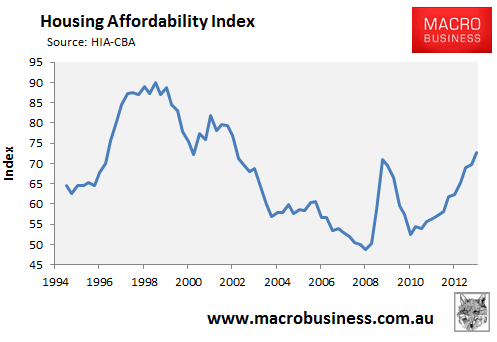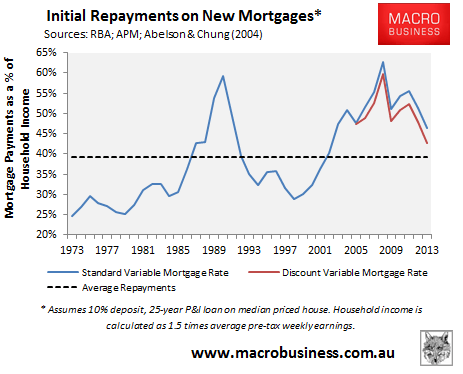
The Housing Industry Association (HIA) today released its quarterly housing affordability index for the June quarter of 2013, which registered another improvement. From the Media Release:
The cyclical improvement in housing affordability continued in the June 2013 quarter…
The HIA-Commonwealth Bank Housing Affordability Index increased by 4.4 per cent in the June 2013 quarter to a level of 72.8.
“A synchronised increase across the capital cities and non-metro areas drove the further improvement in the June 2013 quarter. Housing affordability in Australia is now 16.7 per cent higher than in mid-2012,” said HIA Chief Economist, Dr Harley Dale.
“These are certainly encouraging results for those entering the market at this time in the cycle,” commented Harley Dale.
“The considerable reduction in interest rates is more than offsetting recent dwelling price increases,” said Harley Dale. “Current improvements in housing affordability do not represent structural shifts in Australia’s affordability; rather, they represent the dominant impact of cyclical changes in lending rates which will of course be prone to reversal at some point.”
“Genuine, structural improvements to affordability are contingent on a stock of housing supply that grows commensurately with the population and its housing needs,” noted Harley Dale. “Policy reform, led by the Federal Government, needs to be implemented to drive a sustained improvement to residential construction so as to genuinely address the housing affordability challenge in Australia.”
In the June 2013 quarter the HIA-CBA Housing Affordability Index increased in all seven capital cities reported. The strongest quarterly increase occurred for Brisbane with a rise of 10.4 per cent, followed by Hobart (10.0 per cent), Adelaide (7.7 per cent), Canberra and Perth (4.1 per cent), Sydney (3.3 per cent), and Melbourne (2.2 per cent).
The below chart plots the time series since 1994. As you can see, housing affordability is at decade highs, according to the HIA:

As noted previously, I have concerns about this index. How it can claim that housing affordability is currently well above mid-1990 levels is beyond me, given that the median capital city house price in 1994 was only around $150,000 (compared with around $560,000 currently) and variable mortgage rates were just under 9.5% (versus 5.35% currently).
Moreover, averaging out the results from Australia’s four main house price data providers – the ABS, APM, RP Data, and Residex – showed an increase in values of just under 2% over the June quarter. Given that variable mortgage rates fell by only 0.25% over the quarter, and wages growth was subdued, I fail to see how housing affordability could then have risen by a large 4.4%, as proclaimed by the HIA.
In any event, the HIA’s index should really be labelled a “mortgage affordability index”, since it measures the cost of obtaining a mortgage on a median priced home, not the structural cost of housing per se.
By comparison, my own mortgage affordability index, with median house prices derived from Abelson & Chung (2004) and APM, variable mortgage rates from the RBA, and household income measured as 1.5 times average pre-tax weekly earnings. As you can see, affordability has certainly improved in recent times, although it remains below the long-term average (see next chart) and well below the pre-bubble era.


